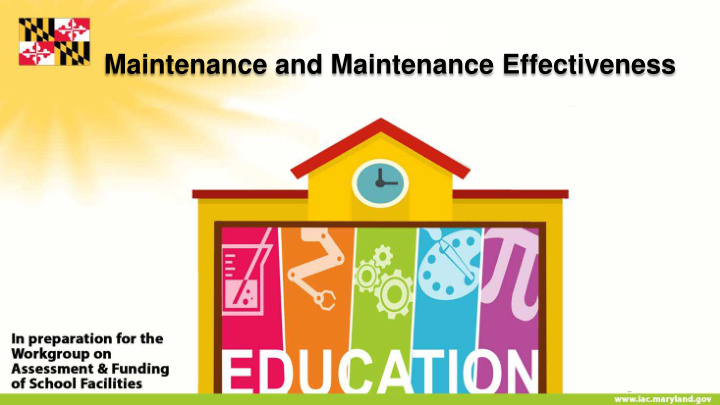



1 Webinar #3 Maintenance and Maintenance Effectiveness Facility Maintenance & Maintenance Effectiveness: Maximizing the Utility of Facilities In Preparation for the Workgroup on Assessment & Funding of School Facilities August 12, 2019 Maryland Interagency Commission on School Construction (IAC)
A Multigenerational Task Reasonable Major Facility Foundation Renovation Lifespan Year 0 10 20 30 40 50 Continual Management and Upkeep… Objectives: Educational Sufficiency + Fiscal Sustainability
Ownership and Cycle of Life
Definition of Maintenance The work required to keep a facility (plant, building, structure, ground facility, utility system, or other real property) in such condition that it may be fully functional and continuously utilized for its expected lifespan, for its intended purpose, and at its maximum energy efficiency. Two Types of Maintenance $ $ $ $ $ 1. Routine Maintenance 2. Capital Maintenance $ $ $ $ $
Major repair, alteration, and replacement of systems, equipment, finished, and components, including their removal and disposal. CAPITAL MAINTENANCE
ROUTINE MAINTENANCE Preventive, predictive, and emergent unscheduled tasks and repairs required to ensure that a facility functions according to its design, as well as its expected lifespan.
Types of Routine Maintenance Strategic Requires Proactive comprehensive Risk Optimized maintenance Based infrastructure Management APR & Predictive Diagnostics to predict Maintenance impending failure Condition-Based Condition-Based Rules-based logic using Maintenance Maintenance sensor data Planned based Preventive Maintenance Preventive Maintenance on time or usage statistics Reactive Maintenance Reactive Maintenance Run to failure
The Vicious Cycle of Reactive Maintenance Standards Drop PM is Missed Morale Drops More Preventable Failures Head / Budget Reduction Resources Taken by Breakdowns More Repeat Work Temporary Repairs
9 What is Preventive Maintenance? System is inspected at least annually Maintenance is planned and scheduled with components replaced or repaired periodically One of the most effective tools to maximize service life of roofing system
10 Preventive Maintenance Schedules Based upon manufacturers’ recommendations and system-condition assessments
HVAC System Replace all Inspections Grease bearings Replace belts Room is too hot Classroom Closed filters Failure PREVENTIVE MAINTENANCE ZONE REACTIVE MAINTENANCE ZONE
Excellent Pavement Condition $2.00 for PP Here Good Fair $4.00 for RM Here Poor Will Cost $12.00 to $16.00 for Very Poor Rehabilitation Here Failed 15 1 5 10 20 25 Age of Pavement
Average Age of LEA Facilities 2010 - 2019 45 Managing for Results Objective 1.1 For each local education agency (LEA), in any one year the deviation from the statewide average age of the square footage for that year will remain constant or improve compared to the deviation recorded for fiscal year 2005 (baseline year). 40 Older facilities Younger facilities 2010 35 2019 Statewide 2011 30 30 Current Increasing 2012 Age 2013 Condition 25 2014 20 of 2015 2016 15 Maryland’s 2017 2018 10 Portfolio 2019 5 0 Simple Portfolio The relative age difference between LEAs has remained status quo, but overall the remaining expected life of facilities Presentation has almost uniformly declined within each LEA.
How Maintenance is Planned A Comprehensive Maintenance Plan (CMP) Defines Core Service Functions and identifies the procedures, tasks, and objectives required Outlines a methodical and measurable approach to maintenance. Includes any activities required to keep a building and its component systems in fully functional condition throughout their design lives, and prevents their premature failure. Examples include scheduled inspections, testing and servicing required to keep manufacturer’s warranties in force; and programmed replacement of consumable parts.
15 Managing Maintenance Computerized Maintenance Management System (CMMS) Assets Material Management Management Breakdown User Maintenance Requests CMMS Reports Work Order Management Preventative Maintenance
Managing Maintenance
Spending on Routine Maintenance Maryland Avg. Annual Spending on Operations & Routine Maintenance (1994-2013) (minus 30% for utilities): 69% $ 767,900,000 Standard: 2% of CRV/year $ 1,106,000,000
Spending on Capital Maintenance % CIP Spent on Replacing Building Systems 50% 40% 31% 30% 20% 12% 10% 0% 2006 2007 2008 2009 2010 2011 2012 2013 2014 2015 2016 2017 2018 2019
Measuring Maintenance Effectiveness IAC Facility Maintenance Assessment (FMA) Covers • Site Exterior • Building Exterior • Building Interior • Equipment and Systems • Maintenance Management
Improved Maintenance Effectiveness Results in Reduced Costs Maintenance Costs Excess Costs Reasonable maintenance costs Predictive Best Practices Failure Reactive Preventive Maintenance Assessment Score
iac.msde@maryland.gov
Measuring and Calculating a Deficiency Score for a Facility Webinar 4 of 4 August 20 th , 2019 12:00 – 1:00 PM Workgroup Meeting August 28 th , 2019 9:00 – 1:00 PM
Recommend
More recommend